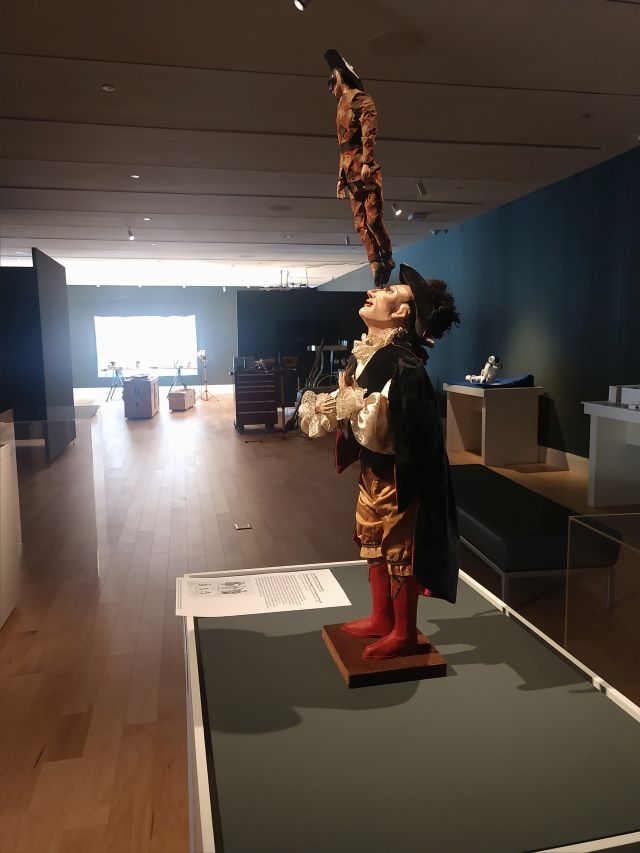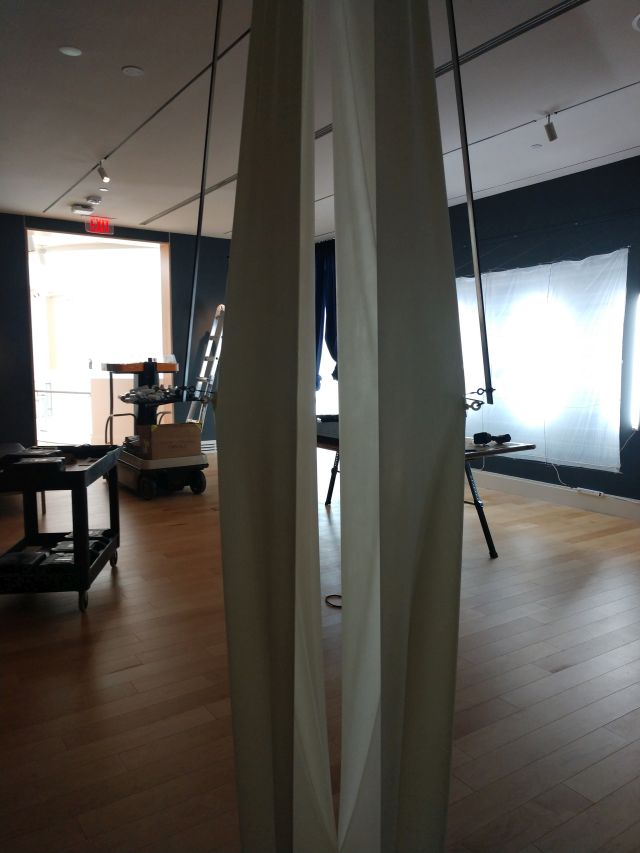We’ve moved into what is arguably one of the most exciting parts of the exhibition process: the installation! This is when all the ideas, research, and objects you’ve been cogitating on for months finally come together, when the show expands from a drawing or 3D model to an actual space visitors can engage. Let’s take a look at what we’ve been doing.
We started the installation phase at a slight advantage. Usually when you install a new show, you repaint the walls to reflect the theme, set a mood, or emphasize particular objects. This means you need to give the paint sufficient time to dry and cure before moving objects into the space. We ended up liking the color from the previous exhibition so well, however, that we decided to keep it for this one too, making only one minor paint change in the form of an accent wall at the entrance. Grant it, there was still a lot of gallery prep to do, from moving temporary walls to repainting the tops of pedestals to match the walls, but it was nice having one less thing to do.
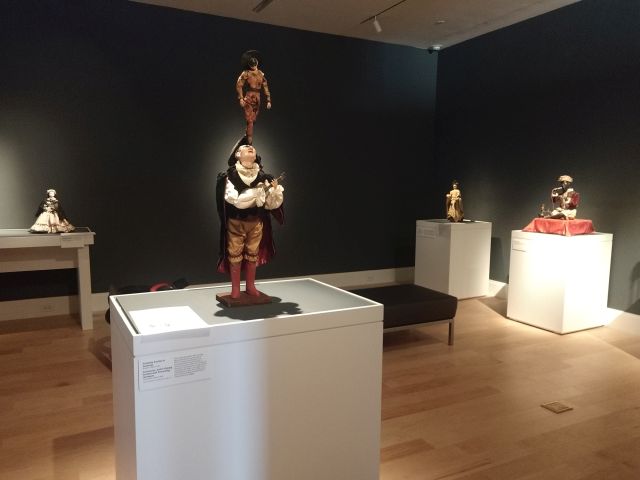
The first pieces to go into the gallery were the automata, since they were already on-site and we needed to clear the space in their usual home, the doll gallery, for another temporary exhibition. We shuffled a few pieces around once we got them in there, but the arrangement has more or less stayed the same as in the model.
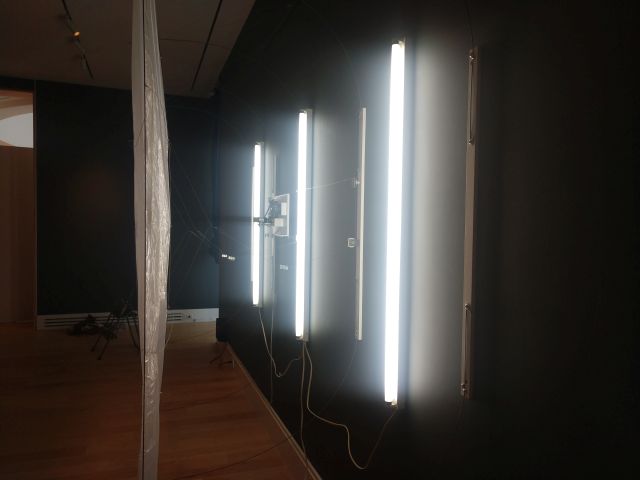
Joseph Morris came in shortly after that to install his works. The placement of his pieces had been more nebulous than the automata because he wanted to see the space first, but once he was in the gallery we figured out the final placement very quickly. He then stayed on site for a couple of days to install the works and show staff and faculty how to maintain them.
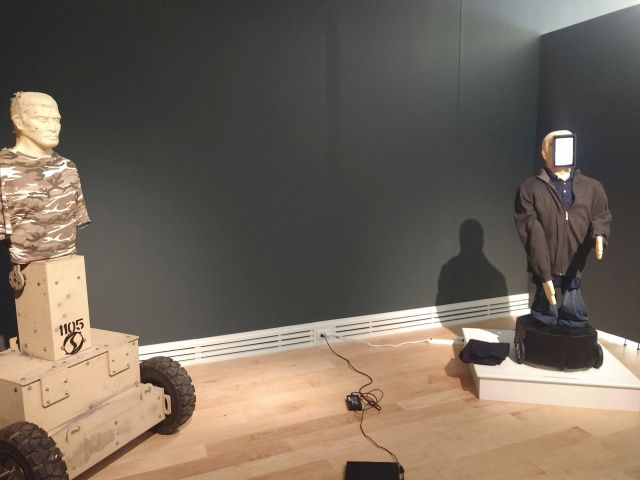
The projects from ODU came in next. These have presented their own challenges because they’re not art objects in the conventional sense of being works intended for a gallery, and as such serve different functions that don’t necessarily translate well in a museum space. Some of these pieces, like David’s Project, are simply so new that this was this first time I’d ever seen what they actually looked like, so it was hard to know how they would interact with the other pieces until they arrived. Other works, like the police trainer from SimIs, required additional curation to render them appropriate to the gallery. I spent one day turning it on and watching it cycle through its different facial expressions so I could decide which ones to keep and which ones to omit from its programming. While the piece is intended to simulate a variety of emotional scenarios for police officers, I opted for neutral or positive expressions rather than overtly aggressive ones. This was especially important since the robot’s face changes every hour to reflect different races or ethnicities, and I didn’t want to accidentally enforce such harmful stereotypes as the Angry Black Person. I also spent some time dressing it up in different clothes, again with the intention of avoiding stereotypes, ultimately opting for a vaguely Mr. Rogers look.
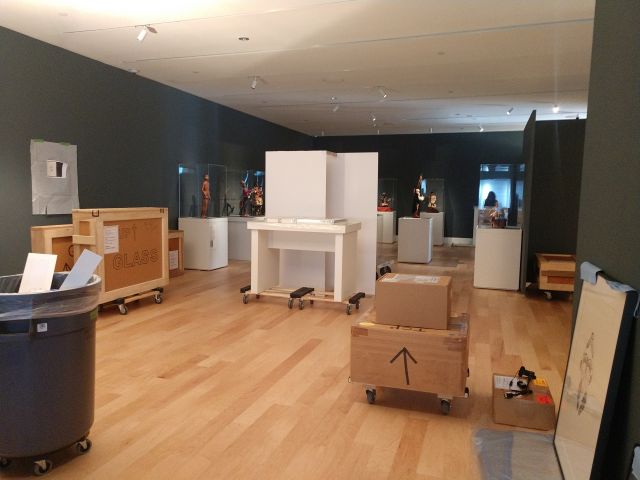
For the last week or so we’ve been focusing on Elizabeth King’s pieces. King is an artist with a meticulous creative practice rooted in deep research and refined craft, and her remarkable attention to detail extends to the installation of her works. As such, she’s been on-site to install her pieces personally, and we’ve shifted some works around in the gallery to better reflect her creative intent.
Overall, the installation has gone smoothly, though I won’t deny that there haven’t been challenges. The winter storms we’ve experienced recently temporarily shut down most campuses in this area for a couple of days, causing us to lose some time. Ongoing delays in shipping have also slowed down the installation process as we wait on materials. And given that an exhibition is a collaboration between different people with overlapping but differing objectives, there’s inevitably been moments of stress and compromise along with excitement and alacrity. It’s just the nature of working with people. Fortunately, the Barry Art Museum includes extra time in its exhibition schedule to accommodate unexpected delays such as weather-related closures, so we’ll still be finished well before the opening date.
On a personal level, it’s been an unusual installation because it’s thrown into sharp relief how my role at the Barry Art Museum is decidedly different from the Roswell Museum. At Roswell, I was involved in every part of the installation process, from repairing the walls to assisting with hanging the works, because I had to be. There were only three of us in the Collections department, so to get anything done, we all had to be on deck when it came to putting up shows.
That hasn’t been the case with this installation. Partly it’s a reflection of my part-time status and my other, more pressing commitments. Between the dissertation, my work at the Career Center, and living in Williamsburg instead of Norfolk, it’s impractical for me to be on-site every day. Yet I’m also not in the gallery all the time because they don’t need me there five days a week to ensure the show goes up. While the Barry Art Museum currently has a small permanent staff, one it will likely expand as the museum continues to grow and develop (remember, it’s only been open for about 3 years), it supplements that staff with contractors such as myself. As a result, it already has several excellent part-time art handlers available for exhibitions, so I’ve done very little of the actual placing and movement of objects myself. I’ll verify the locations of pieces, and I’ve jumped in to help move pedestals or dollies when needed, but overall, my role has been much more about oversight and verification than with physically installing the show. Dressing up the police trainer has been my most hands-on moment.
To be fair, this isn’t the first time I’ve taken on a more supervisory role. I didn’t install any artworks at Shelburne, for instance, and as an intern at the DMA I wasn’t even allowed to handle art without the supervision of an art handler or registrar. Yet I spent by far the most time at the Roswell Museum, and it was my most recent experience prior to working at the Mariners’ Museum and the Barry, so in many ways it’s the experience that’s most affected me as a curator. But no two museums are alike, and what was the status quo at one institution won’t necessarily be the case at another.
It’s something I’ve been talking about with Brandon, because he experienced a similar shift when he started working at Colonial Williamsburg. Like me, as Preparator at the Roswell Museum he was used to doing a little bit of everything, but his role at CW is more specialized. He initially found this change jarring, and sometimes he misses the variety in tasks, but it also frees him up to focus on his role as an art handler, and to develop his particular skill set through workshops and other trainings. Similarly, by not having to physically install the show myself, I’ve been able to concentrate on other exhibition-related tasks. These have included recording voice-overs for videos that we’ll play in the gallery, and writing up content warning labels, details that didn’t always get the attention they needed in Roswell because I had to help get the works on the walls.
Ultimately, the experience reminds me that the Barry Art Museum is a distinct institution from Roswell with its own approaches to doing things, so accordingly my role will be different. It isn’t necessarily good or bad; it’s just different. But above all else, the most prominent emotion right now is excitement, because it’s only a few more weeks until Motion/Emotion opens to the public on February 11th!
